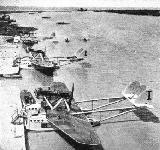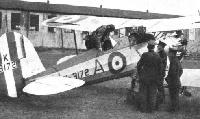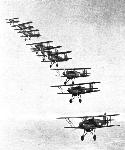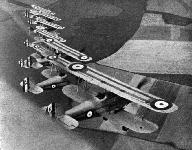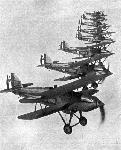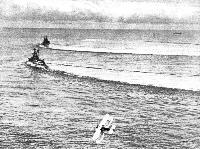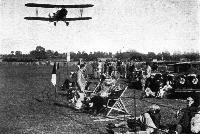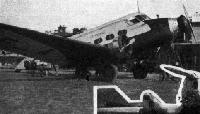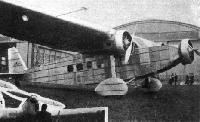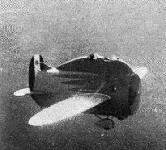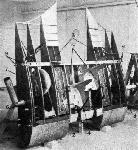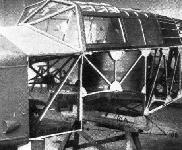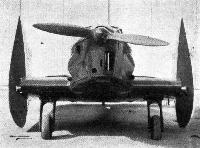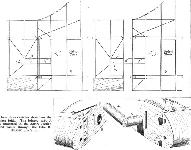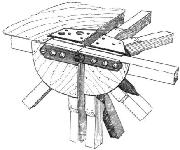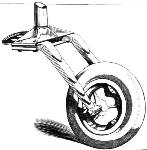Фотографии
-
The Junkers Ju.52 3m., used by Deutsche Luft Hansa.
Самолёты на фотографии: Junkers Ju.52/3m - Германия - 1931
-
Italian flying-boats, Savoia S.55 class, a commercial version the type used by Gen. Balbo on his Atlantic flights.
Самолёты на фотографии: Savoia-Marchetti / SIAI S.55 - Италия - 1924
-
Регистрационный номер: K2423 "AS PANTS THE HART FOR COOLING STREAMS": The machines of No. 33 (Bomber) Squadron just in from a raid gather round the petrol tank at Turnhouse Aerodrome.
Самолёты на фотографии: Hawker Hart - Великобритания - 1928
-
AT THE CRACK OF DAWN: Haar, or sea mist, enveloped Turnhouse Aerodrome on Saturday morning when the "Harts" of No. 33 (Bomber) Squadron took off to bomb the attacking Fleet.
Самолёты на фотографии: Hawker Hart - Великобритания - 1928
-
Регистрационный номер: K3172 THE C.-IN-C.: Air Marshal Sir Robert Brooke-Popham, K.C.B., etc., flew round the Blue aerodromes in a two-seater "Bulldog."
Самолёты на фотографии: Bristol Bulldog - Великобритания - 1927
-
Регистрационный номер: G-ACGW The Reception Tent by daylight. In the foreground (the second machine) can be seen the Bristol Fighter of Empire Air Services.
Самолёты на фотографии: Bristol F.2A/F.2B Fighter - Великобритания - 1916De Havilland Fox Moth / D.H.83 - Великобритания - 1932
-
Регистрационный номер: PH-OST Prince Henry of the Netherlands (extreme left) in front of the Pander "Postjager" on the occasion of the opening of the new clubhouse of the Amsterdam Aero Club. On Prince Henry's left is Mr. Pander, Jr.
Самолёты на фотографии: Pander S-4 Postjager - Нидерланды - 1933
-
A model of the new Pander Mail Carrier, now under construction.
Самолёты на фотографии: Pander S-4 Postjager - Нидерланды - 1933
-
AT LEUCHARS: The Boulton & Paul "Sidestrands" (two "Jupiters") of No. 101 (Bomber) Squadron in readiness for a raid.
Самолёты на фотографии: Boulton Paul Sidestrand / P.29 - Великобритания - 1926
-
"1": No.1 (Fighter) Squadron do a little figure-writing, being naturally proud of their number.
Самолёты на фотографии: Hawker Fury - Великобритания - 1931
-
ECHELON ON THE RIGHT, STEPPED UP: View of No. 1 (Fighter) Squadron in one of the most difficult of all formations.
Самолёты на фотографии: Hawker Fury - Великобритания - 1931
-
No. 1 (FIGHTER) SQUADRON: In the left-hand picture the squadron is in Squadron Formation; in the lower right-hand picture it is in Squadron V, and in the top right one of the flights is shown doing a "flight roll."
Самолёты на фотографии: Hawker Fury - Великобритания - 1931
-
FLIGHTS LINE ABREAST: The clean lines of the Hawker "Furies" (Rolls-Royce "Kestrels") of No. I (Fighter) Squadron from Tangmere show up well in this effective formation.
Самолёты на фотографии: Hawker Fury - Великобритания - 1931
-
ECHELON ON THE RIGHT, STEPPED UP: View of No. 1 (Fighter) Squadron in one of the most difficult of all formations.
Самолёты на фотографии: Hawker Fury - Великобритания - 1931
-
Регистрационный номер: K2045, K2048, K2066 No. 1 (FIGHTER) SQUADRON: The squadron marking is two red lines, parallel on the upper planes, but converging on the fuselage.
Самолёты на фотографии: Hawker Fury - Великобритания - 1931
-
TORPEDO ATTACK: A Blackburn "Ripon" of No. 811 (Torpedo Bomber) Squadron of the Blue Force delivering an attack on H.M.S. Malaya. H.M.S. Warspite, the Red flagship, is ahead.
Самолёты на фотографии: Blackburn Ripon / T.5 - Великобритания - 1926
-
DEFENDING THEIR NATIVE SHORES: The "Wapitis" of No. 603 (City of Edinburgh) (Bomber) Squadron (which had no flotation gear) 30 miles out to sea to bomb the invaders.
Самолёты на фотографии: Westland Wapiti - Великобритания - 1927
-
Регистрационный номер: J9871 STARTING UP: Sqd. Ldr. Lord Clydesdale has brought the City of Glasgow (Bomber) Squadron over from Abbotsinch to Turnhouse, and they are about to take their "Wapitis" off on a raid.
Самолёты на фотографии: Westland Wapiti - Великобритания - 1927
-
THE GAY "GORDONS": No. 40 (Bomber) Squadron have just dropped bombs on the three capital ships, H.M.S. Renown, Warspite and Malaya. Destroyers are scurrying in all directions. Observe how the Main Fleet has changed direction to avoid the air attack.
Самолёты на фотографии: Fairey Gordon / Seal - Великобритания - 1931
-
Регистрационный номер: G-ABCJ Saro "Cloud" (2 "Serval") eight seater.
Самолёты на фотографии: Saunders-Roe Cloud / A.19 - Великобритания - 1930
-
Регистрационный номер: OH-ALK One of the Junkers seaplanes used by Aero OY of Finland,
Самолёты на фотографии: Junkers Ju.52/3mW (See) - Германия - 1933
-
Регистрационный номер: F-AMMY [2] THE FLIGHT TO MOSCOW: The new Dewoitine D.332 monoplane just before leaving Le Bourget for Moscow, with M. Pierre Cot, Air Minister, on board.
Самолёты на фотографии: Dewoitine D.332 / D.333 / D.338 / D.620 - Франция - 1933
-
Регистрационный номер: F-AMMY [2] The latest Dewoitine D.332.
Самолёты на фотографии: Dewoitine D.332 / D.333 / D.338 / D.620 - Франция - 1933
-
PRACTICAL RESEARCH: Sir John Carden, who has been doing a lot of useful experimental work in connection with silencers for aircraft engines, with his specially silenced Klemm, which won the prize for the "quietest engine" at the Hook Aerial Garden Party on September 6
Самолёты на фотографии: Klemm L.25 - L.28 Swallow - Германия - 1927
-
THE "GARDEN" PARTY: An A.S.T. "Cadet" flying over the club enclosure.
Самолёты на фотографии: Avro Cadet / Type 631/643 - Великобритания - 1932
-
Регистрационный номер: G-ABYC READY FOR THE START: The five machines lined up at Portsmouth Aerodrome, before starting for the race round the Isle of Wight.
Самолёты на фотографии: Avro Cadet / Type 631/643 - Великобритания - 1932
-
AWAY UP NORTH: The D.H. "Dragon," operated by Highland Airways on their Inverness - Orkney service, at Wideford Airport.
Самолёты на фотографии: De Havilland Dragon / D.H.84 - Великобритания - 1932
-
OUR AIR-MINDED PREMIER: Mr. Ramsay MacDonald alighting from a "Dragon" at Aldergrove, Ulster, after a flight from Lossiemouth on August 30 to visit the Marquis and Marchioness of Londonderry. He returned to Hendon on September 3 in a R.A.F. machine.
Самолёты на фотографии: De Havilland Dragon / D.H.84 - Великобритания - 1932
-
ENTERPRISE: Western Airways find that traffic for their service between Cardiff and Bristol is growing rapidly. They are now using this "Dragon." Mr. Norman. Edgar is on the left with Messrs. C. R. Cubitt and G. W. Monk, his pilots, next to him. Lt. Col. D. B. Gray, on the right, is a new Director of the firm.
Самолёты на фотографии: De Havilland Dragon / D.H.84 - Великобритания - 1932
-
Регистрационный номер: G-AAUC Malakal Aerodrome (Sudan): Imperial Airways' Horsa landing on the finished runway. The machine is actually touching the southern turning circle, and the reeds seen in the background are in the backwater of the Nile, which runs beside the aerodrome.
Самолёты на фотографии: Handley Page H.P.42 / H.P.45 - Великобритания - 1930
-
The Wibault-Penhoet, another type used by Air-France.
Самолёты на фотографии: Wibault Wibault 280 - Франция - 1930
-
One of the French commercial aircraft which were flown to Moscow to show the Russians what France can produce in this way. The Wibault-Penhoet 282T.
Самолёты на фотографии: Wibault Wibault 280 - Франция - 1930
-
(from left to right) A. L. Naish and B. Brady, who hold the sole selling agency for England, Ireland and Wales for this machine, N. S. Norway, A. H. Tiltman, and Lord Granthorpe (Chairman), the Directors of Airspeed, Ltd.
Самолёты на фотографии: Airspeed Courier / AS.5 - Великобритания - 1933
-
Самолёты на фотографии: Airspeed Courier / AS.5 - Великобритания - 1933
-
Регистрационный номер: VH-UXX READY TO TRY AGAIN: Mr. C. T. Uhn is ready to make another attempt to fly the Atlantic in the Avro 10 Faith in Australia, which has now been repaired by A. V. Roe, Ltd., at their Manchester works. Our picture shows the machine and its crew - reading from left to right, Messrs. Allen, Ulm, Taylor and Edwards.
Самолёты на фотографии: Avro Ten / Type 618 - Великобритания - 1928
-
Side elevation of the new Avro Commercial monoplane.
Самолёты на фотографии: Avro Type 642 - Великобритания - 1933
-
Регистрационный номер: G-ABFR THE HULL-GRIMSBY AIR FERRY: A snap of the Blackburn "Segrave" monoplane, operated by East Yorkshire Motor Services, Ltd., and North Sea, Aerial & General Transport, Ltd., on the Hull-Grimsby air ferry, flying over Hull Docks.
Самолёты на фотографии: Blackburn Segrave Meteor / B-1 - Великобритания - 1930
-
Регистрационный номер: K3589 MINUS ITS "MOULDY": A Blackburn "Baffin" (Bristol "Pegasus" engine) torpedo bomber undergoing tests.
Самолёты на фотографии: Blackburn Baffin / B-5 - Великобритания - 1933
-
Another French machine - the Breguet 19 Commercial.
Самолёты на фотографии: Breguet Br.280 - Франция - 1928
-
THE KUALA LUMPUR FLYING CLUB: Our picture shows the recently erected Club hangar with three of the Club "Moths," together with another "Moth" and Comper "Swift," privately owned respectively by Dr. (Miss) Robertson and Mr. Birch, both members of the Club.
Самолёты на фотографии: Comper Swift / CLA.7 - Великобритания - 1930De Havilland Gipsy Moth / Moth X - Великобритания - 1928
-
One of the French commercial aircraft which were flown to Moscow to show the Russians what France can produce in this way. C. de Vernheilh's Couzinet monoplane Biarritz.
Самолёты на фотографии: Couzinet Couzinet 30 / 33 - Франция - 1931
-
Регистрационный номер: EC-W19, EC-W20, EC-W21, EC-W22 FOR THE SPANISH GOVERNMENT TOPOGRAPHICAL SURVEY DEPARTMENT: Four de Havilland "Fox Moths" ("Gipsy Major") which have been specially equipped lor aerial survey work.
Самолёты на фотографии: De Havilland Fox Moth / D.H.83 - Великобритания - 1932
-
H.M.S. Furious: The Fairey "3 F" machines of No. 822 (Fleet Spotter Reconnaissance) Squadron ready to take off from the deck of the carrier. Note the smoke issuing from below the flying deck.
Самолёты на фотографии: Fairey Fairey IIIF - Великобритания - 1926
-
Регистрационный номер: G-ACJI The new Short Transport monoplane making a test flight.
Самолёты на фотографии: Short Scion / S.16 - Великобритания - 1933
-
Самолёты на фотографии: Cockatoo Dockyard & Engineering Co LJW-6 Codock - Австралия - 1933
-
Регистрационный номер: PH-AIZ The Fokker XX, one of the latest types, with retractable undercarriage, produced for Dutch and other transport lines.
Самолёты на фотографии: Fokker F.XX - Нидерланды - 1933
-
"Monospar" (2 Pobjoy) four seater.
Самолёты на фотографии: General Aircraft Monospar ST-4 - ST-12 - Великобритания - 1932
-
The Clark 43, another American high-speed machine used by Swissair.
Самолёты на фотографии: General Aviation GA-43 - США - 1932
-
Регистрационный номер: S1645 [2] OFF FOR THE NORTH SEA: A Supermarine "Southampton" (two Napier "Lions") taking off under the Forth Bridge to search for the Fleet.
Самолёты на фотографии: Supermarine Southampton / Solent - Великобритания - 1925
-
Регистрационный номер: S1645 [2] AT ZERO HOUR: At noon on Friday five "Southamptons" of Nos. 210 and 201 (F.B.) Squadrons left their moorings at Port Edgar and started off on long reconnaissance.
Самолёты на фотографии: Supermarine Southampton / Solent - Великобритания - 1925
-
Регистрационный номер: L-BACB The Aero A.38, one of the Czech-built aircraft used by C.L.S.
Самолёты на фотографии: Aero A.23 / A.38 - Чехословакия - 1926
-
Регистрационный номер: SP-AGJ A BRITISH SUCCESS IN POLAND: This R.W.D.5 machine, fitted with a "Hermes IV" and piloted by M. Pronaszko, obtained first place in the Fifth Round Poland Flight which took place on September 2-10.
Самолёты на фотографии: RWD RWD-5 - Польша - 1931
-
Регистрационный номер: G-ABFA The first of the large four-engined commercial flyingboats was the Kent (Scipio) which was used for many years on the Mediterranean route of Imperial Airways.
Самолёты на фотографии: Short Kent / S.17 - Великобритания - 1931
-
Самолёты на фотографии: Spartan Cruiser - Великобритания - 1932
-
Регистрационный номер: PH-AFZ AIR TOUR OF HOLLAND: The start from the Waalhaven aerodrome, Rotterdam. The first machine can be seen in the air.
Самолёты на фотографии: Pander E - Нидерланды - 1926
-
A Cams flying-boat used by Air-France on the Mediterranean services.
Самолёты на фотографии: CAMS CAMS 51 / CAMS 53 / CAMS 56 - Франция - 1926
-
Регистрационный номер: G-ABCC THE ANTONI VARIABLE CAMBER WING: As reported in our last issue a successful test was made at Brockworth on September 8 with a Breda fitted with this wing. Our picture shows the machine in flight.
Самолёты на фотографии: Breda Ba.15 - Италия - 1928
-
The Hon. Mrs. Victor Bruce in her "Gipsy Moth."
Самолёты на фотографии: De Havilland Gipsy Moth / Moth X - Великобритания - 1928
-
One of the French commercial aircraft which were flown to Moscow to show the Russians what France can produce in this way. The new Marcel Bloch 120
Самолёты на фотографии: Bloch MB.60 / MB.120 - Франция - 1930
-
Регистрационный номер: G-ABVG The Bombing of the Bucking Ford. The machine is a Miles "Satyr."
Самолёты на фотографии: Miles Satyr / M.1 - Великобритания - 1932
-
LOOKS A BIT FISHY! It is not, however, a photo of a tropical fish taken in the Zoo Aquarium, but an aerial view of the latest Stipa Caproni flying "Venturi tube" - a previous model of which was briefly described in "Flight" of October 20, 1932.
Самолёты на фотографии: Caproni Stipa - Италия - 1932
-
Регистрационный номер: J-BCAH A JAPANESE GLIDER: This glider, designed by Prof. H. Sato, was constructed by the students of the Aeroplane Department of the Imperial University, Fukuoka. Pilot Shizura made a flight of 8 min. 15 sec. on this glider.
Самолёты на фотографии: Sato Jumonji-go (Model 3 Secondary Glider) - Япония - 1933
-
Регистрационный номер: HA-AAL A HUNGARIAN PRODUCTION: Mr. Anthony Banhidy and the "Gerle 13" biplane he has designed.
Самолёты на фотографии: Banhidi / MSrE Gerle 11 - Gerle 18 - Венгрия - 1930
-
Регистрационный номер: F-AMMV ON "SHELL" SERVICE: The latest addition to the "Shell" fleet of aircraft, a Caudron "Phalene" monoplane ("Gipsy Major"), which will be used for the Shell organisation in France.
Самолёты на фотографии: Caudron C.280 / Phalene - Франция - 1932
-
Регистрационный номер: G-ACIX [7] Самолёты на фотографии: Comper Mouse - Великобритания - 1933
-
Регистрационный номер: G-ACIX [7] The centre section is built as a separate unit. 1, an adjustable seat sliding on runners. 2, the starboard wing fuel tank. 3, small lockers for tools and log books. 4, a control column, working the push-push rods which leave the wing at 5, where they end in rubber buffers. 6, the elbow joint upon which the wing folds. 7, an undercarriage wheel retracted. 8 and 9, the wing root spar bolts. 10, the centre attachment point for the fuselage.
Самолёты на фотографии: Comper Mouse - Великобритания - 1933
-
Регистрационный номер: G-ACIX [7] The front part of the fuselage drops over the centre section of the wing and is attached by three bolts at 10a and 10b.
Самолёты на фотографии: Comper Mouse - Великобритания - 1933
-
Регистрационный номер: G-ACIX [7] This shows the method by which the wings are folded on a central joint.
Самолёты на фотографии: Comper Mouse - Великобритания - 1933
-
Регистрационный номер: G-ACIX [7] This front view show the neat design of the undercarriage. The clean engine cowling around the "Gipsy Major" and the small space taken by the "Mouse" when folded should be noted.
Самолёты на фотографии: Comper Mouse - Великобритания - 1933
-
Регистрационный номер: G-ACIX [7] The cabin of the "Mouse" is light and airy, as it is fitted with a form of sunshine roof. The small locker in the wing root can be used for tools and log books. The luggage locker, as shown, holds three suit cases, which are supplied with the machine.
Самолёты на фотографии: Comper Mouse - Великобритания - 1933
-
Регистрационный номер: G-ACIX [7] The front view emphasises the clean design.
Самолёты на фотографии: Comper Mouse - Великобритания - 1933
-
The tail plane on the left has a boxed wooden spar with steel ribs. The rudder on the right is all steel.
Самолёты на фотографии: Comper Mouse - Великобритания - 1933
-
Details of the retractable undercarriage.
Самолёты на фотографии: Comper Mouse - Великобритания - 1933
-
These three sketches show how the wing folds. The jointed tube A is anchored in the centre section and passes through the tube B.
Самолёты на фотографии: Comper Mouse - Великобритания - 1933
-
This explains the general structure of the wing.
Самолёты на фотографии: Comper Mouse - Великобритания - 1933
-
A fuselage joint between the rear portion and the cabin; large plywood biscuits and steel fish plates are used.
Самолёты на фотографии: Comper Mouse - Великобритания - 1933
-
The tail wheel mounted on a spring steel fork.
Самолёты на фотографии: Comper Mouse - Великобритания - 1933
-
A sketch explains the action of the push-push rods for working the ailerons, while at the same time providing a system which does not have to be uncoupled when the wings are folded.
Самолёты на фотографии: Comper Mouse - Великобритания - 1933
-
Comper "Mouse" D.H. Gipsy "Major" Engine
Самолёты на фотографии: Comper Mouse - Великобритания - 1933
Статьи
- Flight
- Flight Advertisements

